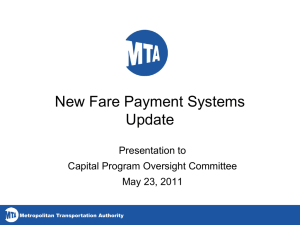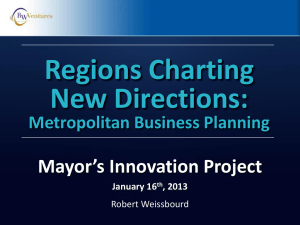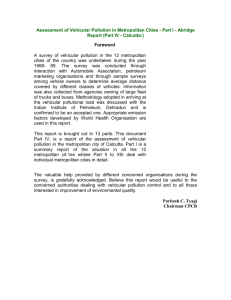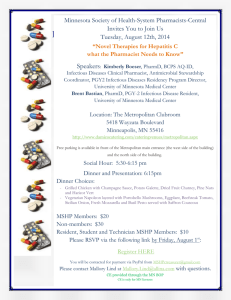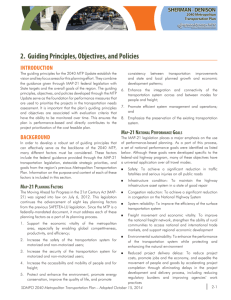Other factors determining congestion
advertisement
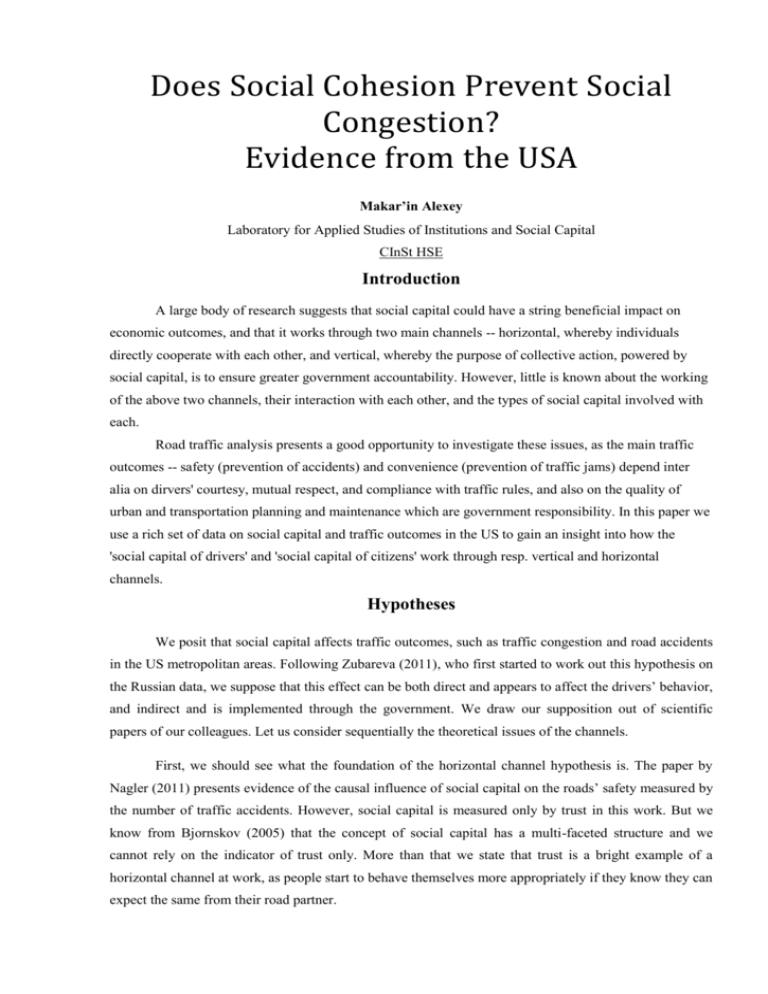
Does Social Cohesion Prevent Social Congestion? Evidence from the USA Makar’in Alexey Laboratory for Applied Studies of Institutions and Social Capital CInSt HSE Introduction A large body of research suggests that social capital could have a string beneficial impact on economic outcomes, and that it works through two main channels -- horizontal, whereby individuals directly cooperate with each other, and vertical, whereby the purpose of collective action, powered by social capital, is to ensure greater government accountability. However, little is known about the working of the above two channels, their interaction with each other, and the types of social capital involved with each. Road traffic analysis presents a good opportunity to investigate these issues, as the main traffic outcomes -- safety (prevention of accidents) and convenience (prevention of traffic jams) depend inter alia on dirvers' courtesy, mutual respect, and compliance with traffic rules, and also on the quality of urban and transportation planning and maintenance which are government responsibility. In this paper we use a rich set of data on social capital and traffic outcomes in the US to gain an insight into how the 'social capital of drivers' and 'social capital of citizens' work through resp. vertical and horizontal channels. Hypotheses We posit that social capital affects traffic outcomes, such as traffic congestion and road accidents in the US metropolitan areas. Following Zubareva (2011), who first started to work out this hypothesis on the Russian data, we suppose that this effect can be both direct and appears to affect the drivers’ behavior, and indirect and is implemented through the government. We draw our supposition out of scientific papers of our colleagues. Let us consider sequentially the theoretical issues of the channels. First, we should see what the foundation of the horizontal channel hypothesis is. The paper by Nagler (2011) presents evidence of the causal influence of social capital on the roads’ safety measured by the number of traffic accidents. However, social capital is measured only by trust in this work. But we know from Bjornskov (2005) that the concept of social capital has a multi-faceted structure and we cannot rely on the indicator of trust only. More than that we state that trust is a bright example of a horizontal channel at work, as people start to behave themselves more appropriately if they know they can expect the same from their road partner. Second, we examine what papers persuade us in the possible existence of the vertical channel. Social capital influences the quality of municipal governance (Knack, 2002). Civic culture, activism and electoral behavior address the quality of bureaucracy since they make the government more accountable. When the government is more accountable it has the incentives to provide a better supply of public goods (for example our case it is supply and maintenance of traffic networks). The studies of urban experts (Downs, 2004) have shown that better traffic networks mean lower congestion. So, social capital indeed might be important for traffic outcomes. Data Data on congestion is taken from an open access database which is constructed by Texas Transportation Institute. It is available for 101 metropolitan areas for the period from 1982 to 2009. The data used in this database is combined primarily from the traffic volume data from the Federal Highway Administration (FHWA) and from other sources. The vertical channel of social capital concept is measured in our research by indicators from the source ‘Civic Life in America’, which collects it from different sources, but mainly from CPS1 supplements, such as CPS Civic Engagement Supplement or Voting and Registration Supplement. Data is available for the year of 2008 for 51 metropolitan areas. We have chosen 9 indicators of social capital, which we consider to reflect vertical channel best: actual voting rate, any nonelectoral participation, volunteer rate, percent of adults who work with neighbors, any group involvement, involvement in service or civic associations, percent of adults who are the group officers or committee members, percent of adults who frequently dine with HH members and discuss politics. Data on traffic accidents and on the horizontal aspect of social capital is searched for at the moment. However, we have a good reason to be optimistic to find the data for metropolitan areas because the similar data for the states of the USA has been found by Nagler (2011). Other factors determining congestion As control variables, we have used various indices that could increase traffic itself or could complicate or simplify the collective action and self-organization of the society. Our controls include (the log of) the number of peak-time travelers2, (the log of) per capita income3, unemployment rate4, percent 1 The Current Population Survey (CPS) is a monthly survey of about 60,000 households conducted by the Bureau of the Census for the Bureau of Labor Statistics. Here and further the explanation of social capital variables is taken from the Civic Life In America Technical Note. 2 Data are for 2008 and are from open Texas Transportation Institute database for MSAs. 3 Data are for 2006 and are from the U.S. Bureau of the Census, State and Metropolitan Area Data Book, "Metropolitan areas" Table B-8 4 Data are for 2006 and are from the U.S. Bureau of the Census, State and Metropolitan Area Data Book, "Metropolitan areas" Table B-9 of adults with a bachelor’s diploma5, measures of ethnic and income polarization and the density of population (the log of) in this very metropolitan area. Model estimating We have estimated the standard model with control variables, where the dependent variable was an output index (OI), and the explanatory variable: one social capital variable per one regression, and control variables. We include only one vertical channel social capital variable per regression because of high correlation between them. 𝑛 𝑂𝐼 = 𝛼 + 𝛽1 𝑉𝑒𝑟𝑡𝑖𝑐𝑎𝑙 + ∑ 𝐶𝑜𝑛𝑡𝑟𝑜𝑙𝑖 𝛾𝑖 + 𝜀 𝑖=1 Our major goal is to estimate the following model, where the different aspects of social capital are included simultaneously. We suppose that these two aspects represent different mechanism of influence, so the model should not suffer from multicollinearity. 𝑛 𝑂𝐼 = 𝛼 + 𝛽1 𝑉𝑒𝑟𝑡𝑖𝑐𝑎𝑙 + 𝛽2 𝐻𝑜𝑟𝑖𝑧𝑜𝑛𝑡𝑎𝑙 + ∑ 𝐶𝑜𝑛𝑡𝑟𝑜𝑙𝑖 𝛾𝑖 + 𝜀 𝑖=1 Preliminary results The results for the first part of our estimation are encouraging. We examined the influence of vertical channel social capital on the road congestion index. Despite the long-distant mechanism of the influence, some variables of social capital are highly significant even after controlling for population and its density, employment rate, income, inequality and educational attainments that might increase or decrease the society’s capacity for self-organizing in making the authorities accountable. Vote enrollment, any group involvement, the percentage of adults who are the officers in any group and civic group involvement are among such significant social capital variables. It is really surprising that vertical channel is represented so strongly in metropolitan areas’ dimension, not only because the mechanism of influence is indirect and ambiguous, but also because the influence should have decreased while moving away from counties’ level. The main results are provided in the Table1 in the Appendix. We also argue that the derived result is robust to changes in congestion indices. Further research The main goal of our further analysis now is to gather the new data on horizontal channel social capital and on road accidents, and then estimate both models for congestion and for accidents as the output indices. If the results are as encouraging as the results of the first part of our analysis, the hypothesis that splitting of social capital into two parts may be examined. 5 Data are for 2006 and are from the U.S. Bureau of the Census, State and Metropolitan Area Data Book, "Metropolitan areas" Table B-4 References 1. Bjørnskov, Ch., ‘The multiple facets of social capital’ // European Journal of Political Economy, 22, 22– 40, 2006 2. Downs A.,(2004) Still stuck in traffic: coping with peak-hour traffic congestion, Brookings Institution Press, Washington D.C. 3. Knack, S., ‘Social Capital and the Quality of Government: Evidence from the United States’ // American Journal of Political Science vol. 46, 40, 772-785, 2002. 4. Nagler, M., ‘Does Social Capital Provides Safety On Roads’ // Economic Inquiry, 2011 5. Zubareva, D., ‘Social Capital and the Traffic: Roads and Authorities that We Choose’, CInSt WP10/2011/03 (in Russian) Appendix Table 1. Determinants of Road Congestion Index (RCI)

